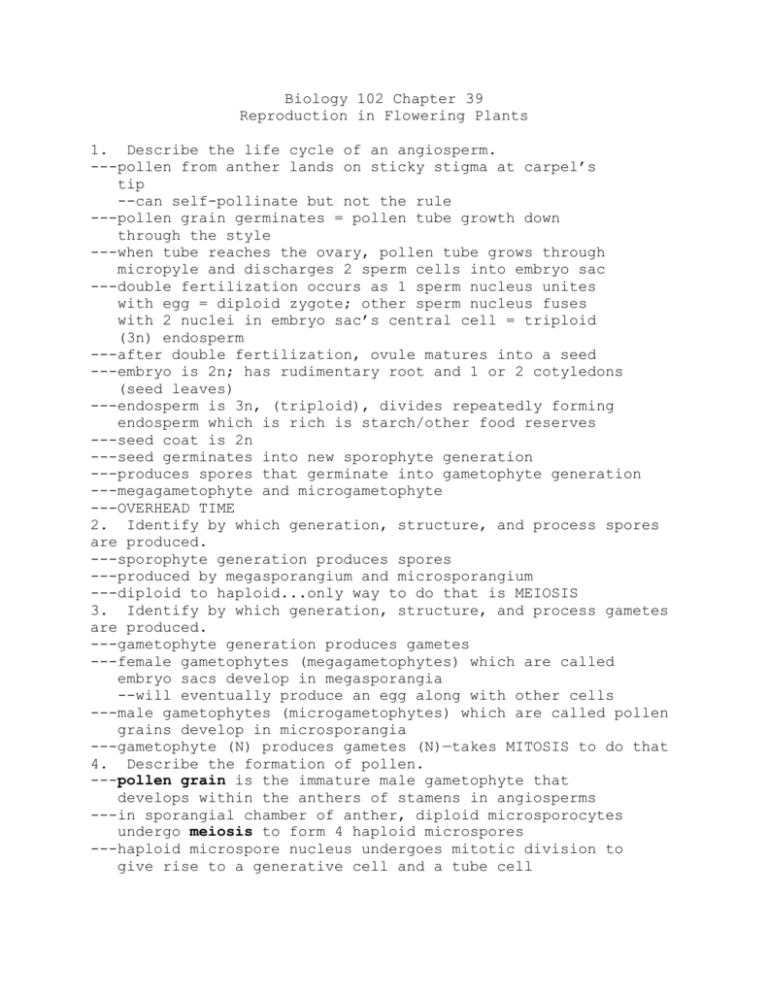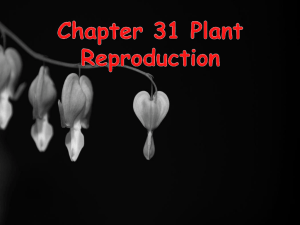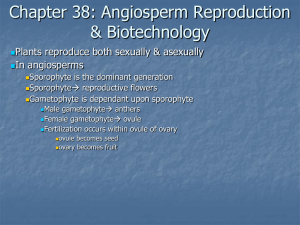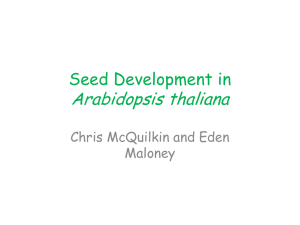Chapter 39
advertisement

Biology 102 Chapter 39 Reproduction in Flowering Plants 1. Describe the life cycle of an angiosperm. ---pollen from anther lands on sticky stigma at carpel’s tip --can self-pollinate but not the rule ---pollen grain germinates = pollen tube growth down through the style ---when tube reaches the ovary, pollen tube grows through micropyle and discharges 2 sperm cells into embryo sac ---double fertilization occurs as 1 sperm nucleus unites with egg = diploid zygote; other sperm nucleus fuses with 2 nuclei in embryo sac’s central cell = triploid (3n) endosperm ---after double fertilization, ovule matures into a seed ---embryo is 2n; has rudimentary root and 1 or 2 cotyledons (seed leaves) ---endosperm is 3n, (triploid), divides repeatedly forming endosperm which is rich is starch/other food reserves ---seed coat is 2n ---seed germinates into new sporophyte generation ---produces spores that germinate into gametophyte generation ---megagametophyte and microgametophyte ---OVERHEAD TIME 2. Identify by which generation, structure, and process spores are produced. ---sporophyte generation produces spores ---produced by megasporangium and microsporangium ---diploid to haploid...only way to do that is MEIOSIS 3. Identify by which generation, structure, and process gametes are produced. ---gametophyte generation produces gametes ---female gametophytes (megagametophytes) which are called embryo sacs develop in megasporangia --will eventually produce an egg along with other cells ---male gametophytes (microgametophytes) which are called pollen grains develop in microsporangia ---gametophyte (N) produces gametes (N)—takes MITOSIS to do that 4. Describe the formation of pollen. ---pollen grain is the immature male gametophyte that develops within the anthers of stamens in angiosperms ---in sporangial chamber of anther, diploid microsporocytes undergo meiosis to form 4 haploid microspores ---haploid microspore nucleus undergoes mitotic division to give rise to a generative cell and a tube cell ---wall of microspore thickens and becomes sculptured into species-specific pattern ---these 2 cells and thickened wall are the pollen grain; an immature male gametophyte 5. Explain the relationship between pollen and microgametophyte. ---pollen grain (microgametophyte/male gametophyte) develop in microsporangia ---can be viewed as synonymous, botanist would object 6. With reference to the mature microgametophyte (germinating pollen grain), distinguish among generative nucleus, tube nucleus, and sperm nucleus. ---pollen grain becomes mature male gametophyte when the generative cell (nucleus) divides to form two sperm (mitosis) ---both sperm formed have haploid nuclei ---tube cell (with its nucleus) responsible for pollen tube growth 7. Describe the development of an embryo sac, and explain what happens to the egg and polar nuclei. ---ovule is structure which forms within chambers of plant ovary and contains the female gametophyte ---female gametophyte is the embryo sac ---megasporocyte in sporangium of each ovule grows & goes through meiosis to form 4 haploid megaspores --only 1 usually survives ---remaining megaspore grows and its nucleus undergoes three mitotic divisions, forming one large cell with 8 haploid nuclei ---membranes partition this into multicellular embryo sac ---within the embryo sac --egg cell is located at one end, flanked by 2 other cells (synergids) --at opposite end are 3 antipodal cells --other 2 nuclei (polar nuclei) share cytoplasm of large central cell --at end containing egg is micropyle (opening through integuments surrounding embryo sac 8. Outline the process of double fertilization and describe the function of endosperm. ---double fertilization is the union of two sperm cells with two cells of the embryo sac ---after adhering to a stigma, pollen grain germinates & extends pollen tube between cells of style toward ovary ---generative cell divides (mitosis) to form two sperm ---pollen grain with a tube enclosing 2 sperm = mature male gametophyte ---directed by chemical attractant, usually calcium, tip of pollen tube enters through micropyle and discharges 2 sperm nuclei into embryo sac ---one sperm unites with egg to form zygote ---other sperm combines with two polar nuclei to form a 3n nucleus in large central cell of embryo sac ---this central cell will give rise to endosperm which is a food storing tissue 9. Describe the relationship between the ovary in a flower of a plant and the fruit produced by the plant. Do the same for the ovule and seed. ---after fertilization, ovary wall of flowering plant, together with its seeds, develop into a fruit ---fruit may consist of only mature ovary and its seeds, or may include other parts of the flower or structures closely related to it ---a fruit protects the seeds and aids in their dispersal by wind or animals ---a fruit develops from the ovary of the flower while seeds are developing from the ovules ---a true fruit is a ripened ovary --pollination triggers hormonal changes that cause ovary to grow --wall of ovary thickens to become the pericarp --transformation of flower into fruit parallels seed development --in most plants, fruit does NOT develop without fertilization of the ovules -parthenocarpic plants are an exception ---in some angiosperms, other floral parts also contribute to formation of what we call fruit ---simple fruit derived from single ovary; --cherries (fleshy); soybeans (dry) ---aggregate fruit derived from single flower with several separate carpels --strawberries ---multiple fruit derived from an inflorescence or separate tightly clustered flowers --pineapple ---OVULE develops into seed containing an embryo and supply of nutrients ---protective seed coat is formed from integuments of ovule 10. Compare and contrast the parts of a seed of a monocot and that of eudicot. ---monocot seed has only one cotyledon whereas a dicot seed has two cotyledons ---some dicot seeds have fleshy cotyledons because they have absorbed food from the endosperm ---others (castor bean) retain food supply as endosperm and have cotyledons that are very thin --cotyledons will absorb food from endosperm & transfer to embryo when seed germinates ---seed of monocot has only one cotyledon ---members of grass family (including corn & wheat) have specialized type of cotyledon called scutellum (small shield) --scutellum very thin with large surface area pressed against endosperm for absorbing nutrients during germination ---embryo of grass seed enclosed by sheath consisting of a coleorhiza (covers the root) and a coleoptile (covers the embryonic shoot 11. Explain how fruits help disperse seed. ---fruits may be fleshy and edible or dry and inedible ---dry, winged fruits (ash, elm, maple) blown by wind ---water disperses some fruits (coconuts) ---some “hitch” rides on animals ---some travel through animals (birds and berries) ---some “carried” by animals 12. Define photoperiodism and using this phenomenon, explain how an integrated control system can regulate a plant process such as flowering. ---defined as regulation of processes (flowering, etc.) by the changing length of day (or of night) ---numerous genes participate in process ---FLORAL MERISTEM IDENTITY GENES ---PATTERN FORMATION GENES ---ORGAN IDENTITY GENES --products are transcription factors that mediate expression of still further genes ---only requires one leaf for plant to detect photoperiod and for floral buds to develop ---if all leaves are removed, no photoperiod detection occurs ---is believed unidentified hormone is produced in leaves --moves to buds --or a change in relative []s of 2 more hormones ---this hormone (or mixture) appears to be same in both long-day and short-day plants ---combination of environmental cues (photoperiod) and internal signals (hormones) induces the transition of bud’s meristem from vegetal state into flowering state 13. Distinguish among annual, biennial, and perennial plants. ---annual completes entire life cycle (seed to flower) in less than one year ---biennial grows for all or part of one year, live on into a second year during which it flower, form seeds, and die ---perennial lives for a few to many years during which both growth and flowering occur 14. Distinguish among short-day, long-day, and day-neutral plants. ---short-day plants require a light period shorter than a critical length and generally flower in late summer, fall, and winter --chrysanthemums, poinsettias, some soybeans ---long-day plants flower only when light period is longer than a certain number of hours, generally in late spring and summer --spinach, radish, lettuce, iris, many cereals ---day-neutral plants are unaffected by photoperiod and flower whey reach a certain stage of maturity --tomatoes, rice, dandelions ---was discovered in 1940s that night length, not day length actually controlled flowering & other responses to photoperiod --if daytime period broken by brief exposure to darkness there is no effect on flowering --if nighttime period is interrupted by short exposure to light, plants do NOT flower --short-day plants flower if night is longer than a critical length --long-day plants need a night shorter than critical length 15. Distinguish between phytochrome and florigen. ---phytochrome is regulatory plant pigment existing in either active or inactive form --different wavelengths of light can drive it from one form to the other ---florigen name given suspected “flowering hormone” --photoperiodic induction of leaf induces it to start and continue production of florigen --transported to other parts of plant switching target parts to reproductive mode 16. Define circadian rhythm and explain what happens when an organism is artificially maintained in constant environment. ---circadian rhythm is a physiological cycle with a frequency of about 24 hours ---when organism is sheltered from environmental cues, rhythm may deviate from 24 hours (called free-running periods) and can vary from 21 to 27 hours ---the clock may take days to reset once the cues change ---“period” is length of one cycle ---“amplitude” is magnitude of change over course of a cycle ---period remarkably insensitive to temperature ---periods are highly persistent --continue in environment in which there is NO alternation of light and dark ---periods can be “entrained” (within limits) by light-dark cycles that differ from 24 hours ---brief exposure to light can shift the rhythm causing a a PHASE SHIFT 17. Distinguish among sexual reproduction, vegetative reproduction, and apomixis. ---sexual reproduction involves the formation of some type of gametes (sperm/egg; +/- reproductive cell) --how those gametes are gotten together is a real hoot ---asexual reproduction does not involve the production of gametes ---text defines as “production of offspring from a single parent; occurs without genetic recombination, resulting in a clone ---vegetative reproduction occurs when meristemic tissues composed of dividing, undifferentiated cells can sustain or renew growth indefinitely --parenchyma cells can also divide and differentiate into various types of specialized cells ---two major natural mechanisms of vegetative reproduction ---fragmentation is separation of parent plant into parts that reform whole plants --is most common type of vegetative reproduction ---apomixis is the production of seeds without meiosis and fertilization --diploid cell in ovule gives rise to embryo --ovules mature into seeds which are dispersed --example: dandelion 18. Compare sexual and asexual reproduction in plants and state under what conditions asexual reproduction is advantageous. ---sexual reproduction benefits include the generation of variation, an asset when environment (biotic and abiotic) changes --produces seeds for dispersal to new locations and which can wait until environments become favorable ---asexual reproduction benefits: in stable environment, plants can clone many copies of themselves in a short period --progeny are mature fragments of parent plant -not as fragile as seedlings produced by sexual reproduction 19. Explain the role of tissue culture in plant propagation. ---many plant cells are “totipotent” --condition of possessing all the genetic information and other capacities necessary to form an entire individual ---cultures of undifferentiated tissues can give rise to entire plants ---even have way to “de-differentiate” tissues (Fig. 16.3) ---can use small pieces of tissue from a parent plant --orchids, rhodendendrons ---culturing tiny bits of apical meristem can produce plants free of viruses --lacks developed vascular tissue and viruses tend NOT to enter








